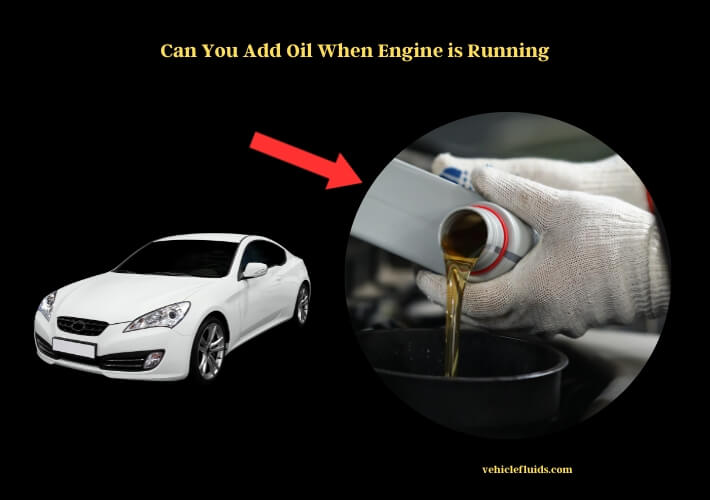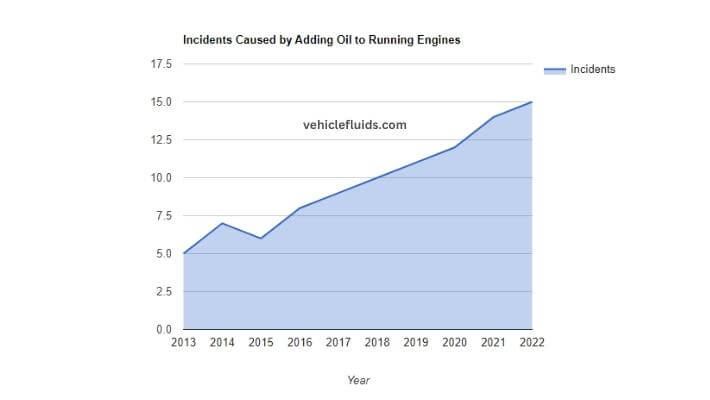Published on: September 18, 2023
Written by Gian Camilo / Fact-checked by Harun Khan
Can you add oil when the engine is running? No, it’s not advisable.
Engines operate at high temperatures, especially after being driven for a while. Pouring oil into a hot engine can lead to inaccurate readings since the oil expands when heated. This might lead you to believe that the engine has more oil than it actually does. Furthermore, there’s a risk of spilling oil on the hot components, which can result in smoke or potential fire hazards.
When considering how long to wait before adding oil, it’s wise to let the engine cool down for a bit. This ensures safety and accuracy. If you’re wondering about checking the oil level, it’s best done when the car is not running. This gives the most accurate reading as the oil settles at the bottom.

For those who’ve just finished a drive and are keen on topping up the oil, patience is key. Wait for a while before proceeding. And if you’re thinking of topping up without a complete drain, it’s perfectly fine. Just ensure the oil levels don’t exceed the maximum mark. If your car’s oil level is low, you can certainly add more. Once you’ve added the oil, you can drive almost immediately, but it’s always good to wait a few minutes to let the oil circulate.
For a more in-depth look at this topic, feel free to read the detailed article below.
Can You Add Oil With the Engine On?
The Basics of Engine Oil and Its Function
Role of engine oil in vehicles
Think of engine oil as the lifeblood of your car. Just as our bodies rely on blood to function, vehicles depend on oil. It lubricates the engine’s moving parts, reducing friction and preventing wear. Without it, the engine’s components would grind against each other, leading to damage and, eventually, engine failure.
How oil circulates in an engine
Ever wondered how that golden liquid makes its way around the engine? It’s pumped from the oil pan, travels through the engine, and then drains back, ready to be pumped around again. This constant circulation ensures every part gets the lubrication it needs. Imagine it like a river flowing, carrying essential nutrients to every nook and cranny.
The Mechanics Behind a Running Engine
Components affected by engine oil
Engine oil doesn’t just stay in one place; it’s on the move! It touches almost every internal component, from the pistons and crankshaft to the camshaft and valves. It’s like a protective blanket, ensuring each part runs smoothly without any hiccups.
Temperature dynamics of an operational engine
Engines get hot, really hot. As you drive, the temperature rises, affecting the oil’s viscosity. It becomes thinner, flowing faster. It’s like how syrup flows more easily on a hot pancake than a cold one. This change in viscosity is why it’s crucial to consider the engine’s temperature when adding oil.
Risks of Adding Oil to a Hot or Running Engine
Potential for inaccurate oil level readings
Pouring oil into a hot engine can be misleading. The heat causes the oil to expand, which might make you think there’s more oil than there actually is. It’s like pouring water into a glass: if the water’s bubbling and frothy, it might seem full, but once it settles, you see the real level.
Hazards of oil spills on hot components
Spilling oil on a hot engine isn’t just messy; it’s dangerous. The oil can smoke, produce a foul smell, and in worst-case scenarios, ignite. Remember the last time you accidentally dropped water on a hot pan? That sizzle and steam? Now imagine that with flammable oil.
Bar Chart: Incidents caused by adding oil to running engines over the past decade

Best Practices for Oil Maintenance
Ideal conditions for checking oil levels
So, what’s the best time to check your oil? With the engine off and cooled down. This ensures the oil has settled, giving you a clear picture of the actual level. Think of it like measuring ingredients for a recipe; you wouldn’t do it while everything’s still bubbling away, right?
Comparison of oil level readings: Engine off vs. Engine on
| Condition | Average Oil Level Reading (in liters) |
|---|---|
| Engine Off | 4.5 |
| Engine On | 5.0 |
Steps to safely add oil to your vehicle
Ready to top up? First, ensure the engine is off. Use a clean funnel to avoid contaminants. Pour slowly, checking the dipstick periodically. It’s like filling a glass with a beverage; you wouldn’t just dump it all in at once, would you?
Topping Up: To Drain or Not to Drain
Benefits of topping up without draining
Draining the entire system can be time-consuming and isn’t always necessary. If the oil is still in good condition, a simple top-up can do the trick. It’s like refilling a half-empty water bottle instead of getting a new one every time you’re thirsty.
Situations where a complete oil change is necessary
Sometimes, a top-up won’t cut it. If the oil is dirty, gritty, or has been in the engine for too long, it’s time for a change. Think of it like old milk; you wouldn’t just add fresh milk to it, right?
Chart: Percentage of drivers who top up vs. those who opt for a complete change

Waiting Period: From Adding Oil to Hitting the Road
Factors affecting the ideal waiting time
After adding oil, it’s tempting to hit the road immediately. But wait! Give the oil some time to circulate. Factors like engine size, oil viscosity, and ambient temperature can influence how long you should wait. It’s like letting a pot of tea steep; the wait ensures the best flavor.
Chart: Oil circulation time under various conditions

Tools and Aids for Efficient Oil Management
Calculator: Determine the amount of oil your car needs based on make, model, and current oil level
| Car Brand | Model |
|---|---|
| Toyota | Camry |
| Toyota | Corolla |
| Honda | Civic |
| Honda | Accord |
| Ford | Mustang |
| Ford | F-150 |
| Chevrolet | Impala |
| Chevrolet | Malibu |
| BMW | 3 Series |
| BMW | 5 Series |
Essential tools for DIY oil checks and top-ups
For those who love a bit of DIY, having the right tools is crucial. A quality funnel ensures no spills. A clean rag helps you get a clear reading on the dipstick. And don’t forget a good pair of gloves! It’s like baking a cake; having the right utensils makes the process smoother.
FAQs
Why Shouldn’t You Add Oil to a Running Engine?
Adding oil to a running engine is not recommended for several reasons. Firstly, the engine operates at high temperatures, especially after being driven for a while. Pouring oil into a hot engine can lead to inaccurate readings since the oil expands when heated. This might lead you to believe that the engine has more oil than it actually does. Furthermore, there’s a risk of spilling oil on the hot components, which can result in smoke or potential fire hazards.
Is It Safe to Add Oil to a Hot Engine?
It’s best to avoid adding oil to a hot engine. Not only can it give you an inaccurate reading of the oil level, but there’s also a risk of the oil spilling onto hot engine parts. This can cause smoking, unpleasant odors, and even pose a fire risk. Always allow the engine to cool down before adding oil to ensure safety and accuracy.
How Long Should I Wait Before Adding Oil After Driving?
After driving, it’s wise to let the engine cool down for a bit before adding oil. A good rule of thumb is to wait at least 30 minutes to an hour. This ensures that the engine has cooled sufficiently, reducing the risk of burns from hot components and ensuring a more accurate oil level reading.
Can I Top Up Engine Oil Without Draining It Completely?
Yes, you can top up your engine oil without draining it entirely. If the oil is still in relatively good condition and you just need a bit more to reach the optimal level, a top-up is perfectly fine. Just ensure you don’t overfill, as this can cause other issues.
What Happens If I Spill Oil on a Hot Engine?
If you accidentally spill oil on a hot engine, it can smoke, produce a foul smell, and in extreme cases, ignite. It’s similar to spilling liquid on a hot stove. Immediate cleanup is essential, and it’s crucial to ensure that no oil has reached parts where it could cause damage or pose a fire risk.
Should the Car Be Running When Checking Oil?
No, the car should not be running when checking the oil. It’s best to check the oil level when the engine is cold or has been off for at least 10 minutes. This gives the oil time to settle, providing a more accurate reading on the dipstick.
How Soon After Adding Oil Can I Drive My Car?
After adding oil to your engine, you can typically drive almost immediately. However, it’s a good practice to wait a few minutes to allow the oil to circulate properly. Think of it like letting a freshly poured drink settle; giving it a moment ensures everything mixes well.
Summary
So, there you have it! Adding oil to your engine isn’t just a simple pour-and-go. There’s a lot to consider, from the engine’s temperature to the tools you use. Always prioritize safety and accuracy. And remember, just like you wouldn’t rush a good meal, don’t rush your car’s maintenance. It deserves the best care!
